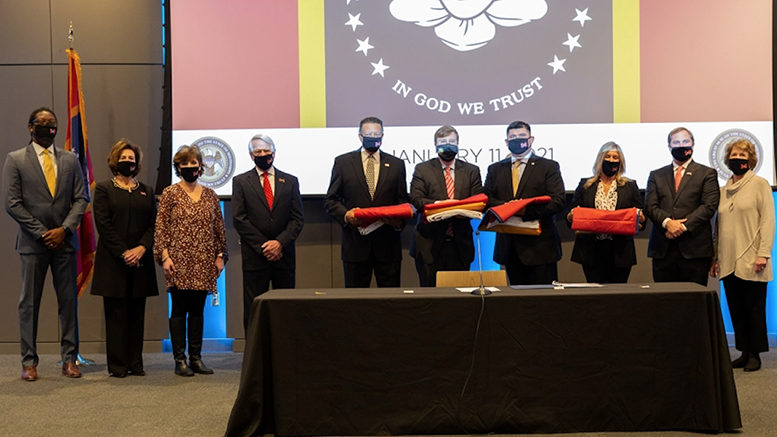- A new Mississippi state flag
- Latest upgrades to ED’s College Scorecard
- Relying more on solar energy
- New Jersey nears making grant program permanent
A new Mississippi state flag
Mississippi has a new flag, thanks in part to the work of a special commission that included a community college president.
Republican Gov. Tate Reeves on Monday signed a bill to update state law with a description of the flag, and later hosted a ceremony to raise the new flag at the state capitol. The new flag, which features a magnolia and the phrase “In God We Trust,” was forwarded by the Commission to Redesign the Mississippi State Flag. Mary Graham, president of Mississippi Gulf Coast Community College and former board chair on the American Association of Community Colleges, served on the commission.
“It’s a historic day in Mississippi as our new state flag was signed into law by Governor Tate Reeves. I was honored to serve on the committee for the flag redesign and for the opportunity to be there today,” Graham posted on Twitter following the event.
State lawmakers last summer removed the former state flag that included the Confederate battle emblem.
Latest upgrades to ED’s College Scorecard
The U.S. Education Department (ED) on Tuesday announced new updates to its College Scorecard that include information on how well borrowers from individual colleges are progressing in repaying their federal student loans, as well as how overall borrower cohorts are faring at certain intervals in the repayment process.
The Scorecard now shows the percentages of borrowers who fall into eight loan repayment statuses two years after entering repayment: paid in full, making progress, delinquency, forbearance, default, not making progress, deferment and loans discharged. The new borrower-based repayment rate provides a more comprehensive picture of repayment and better context than previous versions of College Scorecard repayment rates, which only showed the proportion of borrowers who were and were not making progress, according to ED.
“Prospective students can now see a comprehensive picture of how borrowers from each institution are meeting their federal student loan obligations,” Acting Education Secretary Mitchell Zais said in a statement. “This is the kind of real, unfiltered information students need to make informed, personalized decisions about their education.”
Next week, the department will add to the Scorecard borrower-based repayment rates for individual fields of study. Later this year, ED plans to include information on year-over-year change in cost at each postsecondary institution.
Relying more on solar energy
Community College of Allegheny County (CCAC) is moving forward with a new solar installation that will produce more than a half a megawatt of electricity annually, which is enough energy to power almost 90 homes.
The new solar array will save the western Pennsylvania college about $750,000 in energy costs over the next 28 years, or about $27,000 annually.
Installer BAI will build, operate and maintain the array, and CCAC will pay for the electricity at a contractually defined, predictable rate, according to the college. This will be CCAC’s third major solar installation, but it is the college’s first time using a power purchase agreement.
New Jersey nears making grant program permanent
New Jersey moved closer this week to making permanent a last-dollar state scholarship for qualifying community college students.
The state Senate on Monday voted to establish the Community College Opportunity Grant (CCOG) program as a permanent state financial aid program. The state Assembly passed the bill late last year. It now heads to the governor for his expected signature.
The CCOG, which helps individuals in households earning $65,000 adjusted gross income or less, was first established in the state’s fiscal year 2019 budget. It assisted more than 18,000 students last year, including recent high school graduates and working adults, according to the New Jersey Council of County College, which represents the state’s 18 community colleges.

